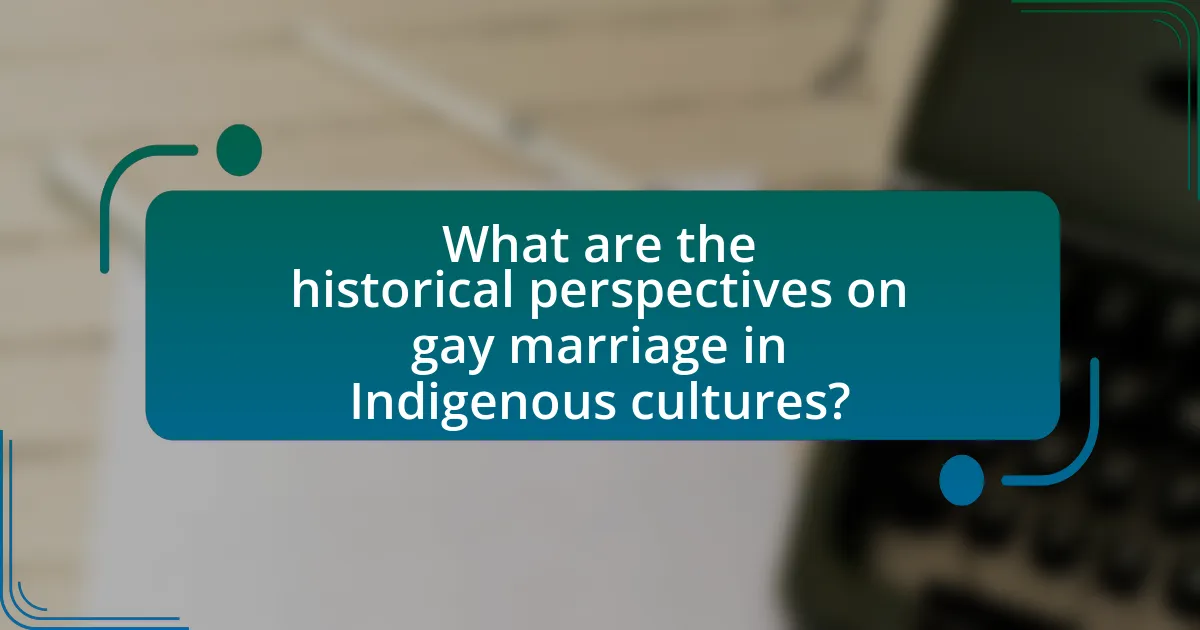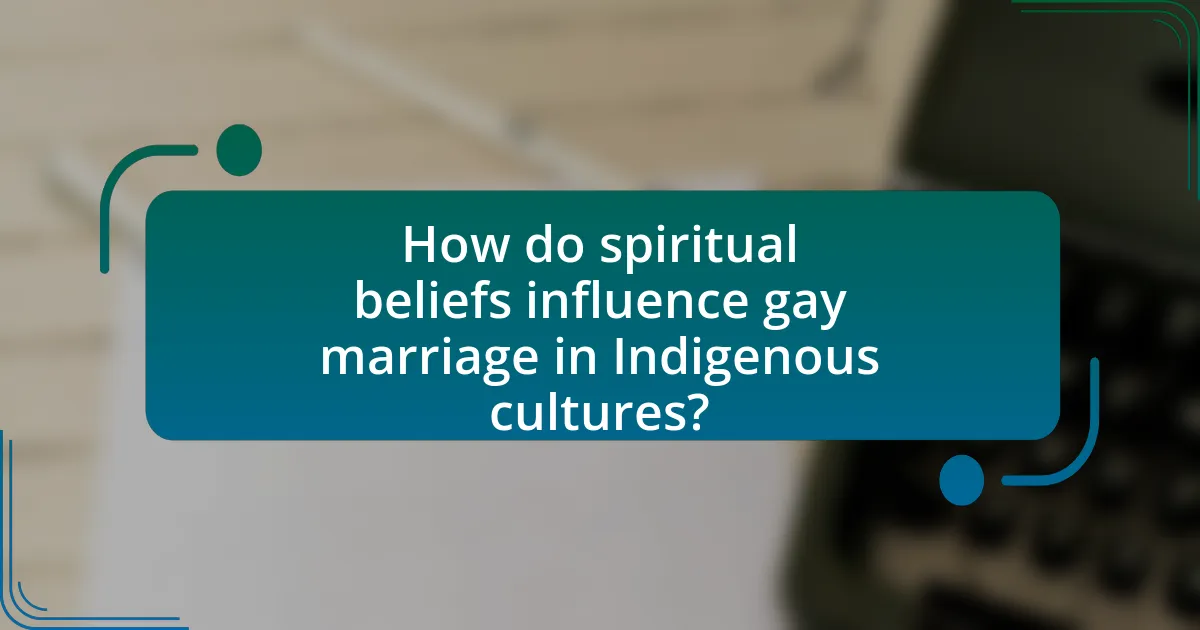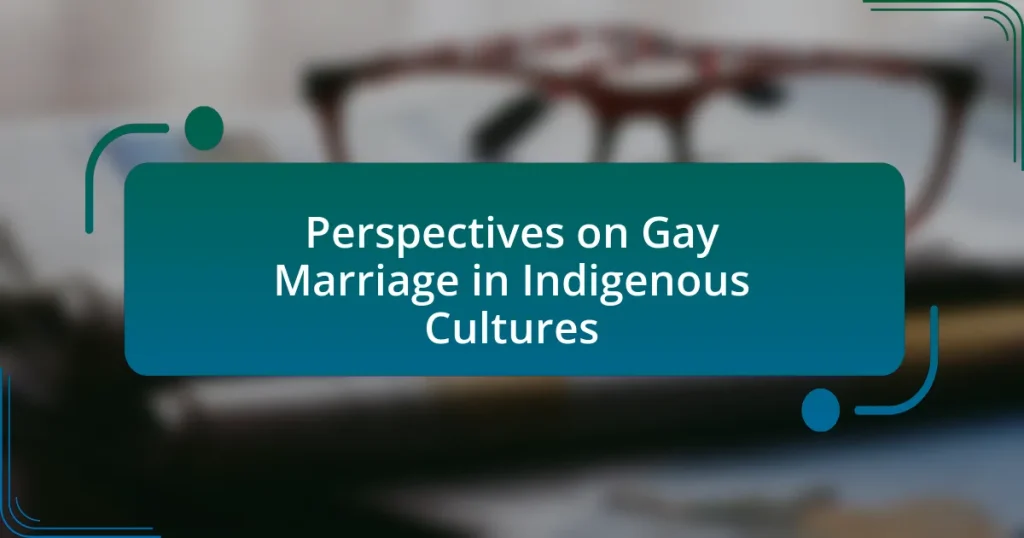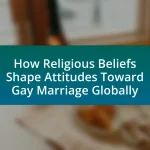The article examines perspectives on gay marriage within Indigenous cultures, highlighting the historical acceptance of diverse sexual orientations and gender identities, particularly through the recognition of Two-Spirit individuals. It discusses how traditional beliefs have shaped views on same-sex relationships, contrasting these with colonial influences that imposed heteronormative values. The article also explores contemporary attitudes towards gay marriage among Indigenous peoples, the role of spirituality in fostering acceptance, and the challenges faced by Indigenous LGBTQ+ individuals regarding marriage. Additionally, it outlines advocacy efforts aimed at promoting inclusivity and the resources available to support Indigenous LGBTQ+ individuals in their pursuit of marriage rights.

What are the historical perspectives on gay marriage in Indigenous cultures?
Historical perspectives on gay marriage in Indigenous cultures reveal that many Indigenous societies recognized and accepted diverse sexual orientations and gender identities long before colonial influences. For instance, numerous Native American tribes acknowledged Two-Spirit individuals, who embodied both masculine and feminine qualities, often holding respected roles within their communities. This acceptance is evidenced by historical accounts and anthropological studies, such as those by Walter L. Williams in “Two Spirits: A Story of Life with the Navajo” and the work of the American Indian Movement, which highlight the cultural significance of same-sex relationships and the spiritual roles of Two-Spirit people. These perspectives contrast sharply with Western notions of marriage, illustrating a rich tapestry of acceptance and recognition of LGBTQ+ identities in Indigenous cultures.
How have traditional beliefs shaped views on gay marriage in Indigenous societies?
Traditional beliefs in Indigenous societies have often fostered acceptance of diverse sexual orientations, including gay marriage. Many Indigenous cultures historically recognized multiple gender identities and sexualities, viewing them as integral to their social fabric. For instance, the concept of Two-Spirit individuals in various Native American tribes illustrates a traditional acknowledgment of non-binary and same-sex relationships, which were often celebrated rather than stigmatized. This acceptance is rooted in spiritual beliefs that honor the balance of gender and sexuality, leading to a more inclusive perspective on marriage that encompasses same-sex unions.
What roles do gender and sexuality play in Indigenous cultural narratives?
Gender and sexuality play significant roles in Indigenous cultural narratives by shaping identity, social structures, and spiritual beliefs. Many Indigenous cultures recognize multiple gender identities beyond the binary framework, often including Two-Spirit individuals who embody both masculine and feminine qualities. This recognition is reflected in various narratives, rituals, and community roles, emphasizing the importance of inclusivity and diversity in gender and sexual expression. For instance, the concept of Two-Spirit is not only a cultural identity but also a spiritual one, often associated with unique roles in ceremonies and community leadership, which highlights the integral connection between gender, sexuality, and cultural heritage in Indigenous societies.
How have colonial influences altered Indigenous perspectives on gay marriage?
Colonial influences have significantly altered Indigenous perspectives on gay marriage by imposing Western heteronormative values and legal frameworks that often marginalized traditional Indigenous understandings of gender and sexuality. Historically, many Indigenous cultures recognized diverse gender identities and same-sex relationships, often integrating them into their social and spiritual practices. However, colonialism introduced rigid binary gender roles and criminalized non-heteronormative relationships, leading to the erasure of Indigenous practices and beliefs surrounding sexual diversity. For example, the imposition of colonial laws in North America criminalized same-sex relationships, which disrupted Indigenous communities’ acceptance of diverse sexual orientations. This shift has resulted in ongoing struggles for recognition and acceptance of gay marriage within many Indigenous communities, as they navigate the legacy of colonialism while attempting to reclaim and revitalize their traditional beliefs.
What are the contemporary views on gay marriage among Indigenous peoples?
Contemporary views on gay marriage among Indigenous peoples vary widely, reflecting diverse cultural beliefs and practices. Many Indigenous communities embrace a more inclusive understanding of relationships, often rooted in traditional concepts of gender fluidity and Two-Spirit identities, which recognize the existence of individuals embodying both masculine and feminine traits. For instance, some tribes, such as the Navajo and Lakota, have historically acknowledged same-sex relationships, viewing them as valid expressions of love and partnership. In recent years, there has been a growing acceptance of gay marriage within various Indigenous groups, influenced by broader societal changes and advocacy for LGBTQ+ rights. This shift is evident in the support for same-sex marriage legislation in some Indigenous nations, highlighting a blend of traditional values and contemporary social justice movements.
How do modern Indigenous communities approach the concept of gay marriage?
Modern Indigenous communities generally approach the concept of gay marriage with a recognition of diverse sexual orientations and gender identities, often rooted in traditional beliefs that honor two-spirit individuals. Many Indigenous cultures historically embraced non-heteronormative relationships, viewing them as integral to community and spiritual life. For instance, some tribes, such as the Navajo and Lakota, have cultural frameworks that support same-sex unions, reflecting a broader acceptance of LGBTQ+ identities within their social structures. This acceptance is increasingly evident in contemporary practices, where many Indigenous leaders advocate for the inclusion of gay marriage as part of their cultural revitalization efforts, emphasizing the importance of love and commitment in all forms.
What are the differences in perspectives among various Indigenous groups?
Various Indigenous groups hold differing perspectives on gay marriage, influenced by their unique cultural, spiritual, and historical contexts. For instance, some Native American tribes, such as the Two-Spirit community, embrace diverse sexual orientations and gender identities, viewing them as integral to their cultural heritage. In contrast, other Indigenous groups may adhere to more traditional views that prioritize heterosexual unions, often influenced by colonial histories and religious beliefs. These differences highlight the complexity of Indigenous perspectives on gay marriage, reflecting a spectrum of acceptance and resistance shaped by each group’s distinct cultural narratives and experiences.

How do spiritual beliefs influence gay marriage in Indigenous cultures?
Spiritual beliefs significantly influence gay marriage in Indigenous cultures by affirming the legitimacy of diverse sexual orientations and relationships. Many Indigenous cultures view sexuality as a fluid spectrum, often integrating spiritual practices that honor same-sex unions as sacred. For instance, the Two-Spirit identity, recognized in numerous Indigenous communities, embodies a blend of masculine and feminine traits, allowing for same-sex relationships to be celebrated within spiritual contexts. This acceptance is rooted in traditional teachings and ceremonies that validate the existence and importance of LGBTQ+ individuals, contrasting with Western perspectives that may impose rigid definitions of marriage. Historical accounts and contemporary practices demonstrate that spiritual beliefs in these cultures often promote inclusivity and respect for all forms of love, thereby influencing the acceptance and celebration of gay marriage.
What role does spirituality play in the acceptance of gay marriage?
Spirituality significantly influences the acceptance of gay marriage within Indigenous cultures by framing relationships through a lens of sacredness and community. Many Indigenous belief systems recognize diverse sexual orientations as part of the natural order, often viewing same-sex relationships as spiritually valid and integral to cultural identity. For instance, some Native American tribes honor Two-Spirit individuals, who embody both masculine and feminine qualities, thus promoting acceptance of gay marriage as a reflection of spiritual balance and harmony. This perspective is supported by anthropological studies, such as those by Walter L. Williams, which highlight the historical presence of same-sex relationships in Indigenous societies, reinforcing the idea that spirituality and acceptance of diverse sexual identities are deeply intertwined.
How do specific Indigenous spiritual practices view same-sex relationships?
Many Indigenous spiritual practices view same-sex relationships positively, often recognizing them as a natural part of human diversity. For example, some Native American cultures honor Two-Spirit individuals, who embody both masculine and feminine qualities, and are often seen as possessing unique spiritual gifts. This recognition is rooted in historical traditions where same-sex relationships were accepted and integrated into community life, as evidenced by various tribal narratives and practices that celebrate love and partnership regardless of gender.
What are the connections between spirituality and community acceptance of gay marriage?
Spirituality significantly influences community acceptance of gay marriage, particularly in Indigenous cultures where spiritual beliefs often emphasize inclusivity and the sacredness of diverse identities. Many Indigenous spiritual traditions recognize two-spirit individuals, who embody both masculine and feminine qualities, thereby fostering a cultural framework that supports non-heteronormative relationships. Research indicates that communities with strong spiritual ties tend to exhibit higher acceptance of gay marriage, as these beliefs can promote values of love, respect, and harmony. For instance, studies show that in tribes where spiritual teachings celebrate diversity, there is a greater likelihood of community support for same-sex unions, reflecting a holistic understanding of human relationships.
How do Indigenous leaders and activists advocate for gay marriage rights?
Indigenous leaders and activists advocate for gay marriage rights by emphasizing the importance of inclusivity and the recognition of diverse sexual orientations within their cultural frameworks. They often draw on traditional teachings that support love and relationships, highlighting that many Indigenous cultures historically embraced various forms of gender and sexual diversity. For instance, some leaders reference the existence of Two-Spirit identities, which embody both masculine and feminine qualities, as a foundation for advocating acceptance of same-sex relationships. This advocacy is further supported by community organizing, public demonstrations, and participation in broader LGBTQ+ movements, aiming to challenge colonial narratives that have marginalized these identities.
What strategies are being employed to promote acceptance of gay marriage?
Strategies employed to promote acceptance of gay marriage include educational initiatives, community engagement, and advocacy through storytelling. Educational initiatives aim to inform individuals about LGBTQ+ rights and the historical context of gay marriage, fostering understanding and empathy. Community engagement involves organizing events and discussions that encourage dialogue among diverse groups, helping to break down stereotypes and misconceptions. Advocacy through storytelling highlights personal experiences of LGBTQ+ individuals, making the issue relatable and humanizing the struggle for acceptance. These strategies have been shown to effectively shift public perceptions, as evidenced by increasing support for gay marriage in various regions following such efforts.
How do these advocacy efforts reflect broader social changes within Indigenous communities?
Advocacy efforts for gay marriage within Indigenous communities reflect broader social changes by highlighting a shift towards inclusivity and recognition of diverse sexual orientations. These movements demonstrate a growing acceptance of LGBTQ+ identities, which contrasts with traditional views that often marginalized these individuals. For instance, many Indigenous cultures historically recognized Two-Spirit people, indicating a pre-colonial acceptance of gender and sexual diversity. Recent advocacy efforts, such as the push for legal recognition of same-sex marriages, signify a reclaiming of cultural narratives and a response to colonial impositions that enforced heteronormative standards. This evolution is evidenced by increasing participation of Indigenous leaders in LGBTQ+ rights discussions, showcasing a commitment to social justice and equality within their communities.

What challenges do Indigenous LGBTQ+ individuals face regarding marriage?
Indigenous LGBTQ+ individuals face significant challenges regarding marriage, primarily due to cultural, legal, and social factors. Many Indigenous communities have traditional beliefs that may not fully accept LGBTQ+ identities, leading to familial and community rejection. Additionally, legal recognition of same-sex marriage can vary widely, with some regions lacking protections for LGBTQ+ rights, which complicates the ability to marry legally. For instance, in the United States, while same-sex marriage is legal nationwide, many Indigenous nations have their own laws that may not recognize such unions, creating a patchwork of legal recognition. Furthermore, Indigenous LGBTQ+ individuals often experience discrimination and stigma, which can hinder their access to resources and support systems necessary for marriage. These challenges highlight the intersection of cultural identity and LGBTQ+ rights within Indigenous contexts.
What societal barriers exist for gay marriage in Indigenous cultures?
Societal barriers for gay marriage in Indigenous cultures include traditional beliefs, community norms, and legal restrictions. Many Indigenous communities hold strong cultural values that prioritize heterosexual relationships, often rooted in historical practices and spiritual beliefs. For instance, some tribes view marriage as a union between a man and a woman for the purpose of family and lineage continuation, which can marginalize same-sex relationships. Additionally, external legal frameworks imposed by colonial governments may not recognize or support Indigenous practices regarding marriage, further complicating the acceptance of gay marriage within these communities. This combination of cultural and legal challenges creates significant obstacles for same-sex couples seeking marriage in Indigenous contexts.
How do discrimination and stigma impact the lives of Indigenous LGBTQ+ individuals?
Discrimination and stigma significantly impact the lives of Indigenous LGBTQ+ individuals by leading to social exclusion, mental health issues, and barriers to accessing essential services. Indigenous LGBTQ+ individuals often face compounded discrimination due to their sexual orientation and cultural identity, resulting in higher rates of depression and anxiety compared to their non-Indigenous counterparts. For instance, a study published in the American Journal of Public Health found that Indigenous LGBTQ+ youth experience higher rates of suicidal ideation, with 39% reporting such thoughts, compared to 24% of non-Indigenous LGBTQ+ youth. Additionally, stigma can hinder their ability to seek healthcare, as many fear discrimination from providers, leading to poorer health outcomes. This intersection of discrimination and stigma creates a challenging environment that affects their overall well-being and quality of life.
What resources are available to support Indigenous LGBTQ+ individuals seeking marriage?
Indigenous LGBTQ+ individuals seeking marriage can access various resources, including community organizations, legal assistance, and cultural support networks. Organizations such as the Two-Spirit Society of Alberta provide advocacy and resources specifically for Two-Spirit individuals, promoting cultural understanding and acceptance of LGBTQ+ identities within Indigenous communities. Additionally, the National Indigenous LGBTQ+ Coalition offers support and resources tailored to the unique needs of Indigenous LGBTQ+ individuals, including guidance on marriage rights and legal processes. Legal aid services, such as those provided by the Indigenous Justice Program, can assist with navigating marriage laws and ensuring that rights are upheld. These resources collectively aim to empower Indigenous LGBTQ+ individuals in their pursuit of marriage while respecting their cultural heritage.
What can be learned from Indigenous perspectives on gay marriage?
Indigenous perspectives on gay marriage reveal a diverse understanding of gender and sexuality that often contrasts with Western norms. Many Indigenous cultures historically recognized and accepted two-spirit individuals, who embody both masculine and feminine qualities, suggesting a more fluid approach to gender and relationships. For instance, the Navajo culture has long acknowledged the existence of nádleehi, individuals who may take on roles traditionally associated with both genders, indicating acceptance of non-heteronormative relationships. This acceptance challenges the binary view of marriage and highlights the importance of community and kinship over rigid definitions of partnership.
How can these perspectives inform broader discussions on marriage equality?
Perspectives on gay marriage in Indigenous cultures can inform broader discussions on marriage equality by highlighting the historical and cultural acceptance of diverse sexual orientations and gender identities within these communities. For instance, many Indigenous cultures have long recognized Two-Spirit individuals, who embody both masculine and feminine qualities, as integral members of their societies, thus challenging the binary understanding of gender and marriage. This recognition can serve as a framework for advocating for inclusive marriage laws that respect and honor the rights of all individuals, regardless of sexual orientation. Furthermore, the experiences of Indigenous peoples in navigating colonial legal systems can provide critical insights into the importance of culturally relevant approaches to marriage equality, emphasizing the need for policies that are not only legally sound but also culturally affirming.
What best practices can be adopted from Indigenous approaches to inclusivity in marriage?
Indigenous approaches to inclusivity in marriage emphasize community involvement, respect for diverse identities, and the recognition of multiple forms of relationships. These practices can be adopted to foster inclusivity in contemporary marriage frameworks. For instance, many Indigenous cultures celebrate Two-Spirit individuals, who embody both masculine and feminine qualities, thereby promoting acceptance of LGBTQ+ identities within marriage. Additionally, the practice of communal decision-making in marriage ceremonies allows for broader participation and acknowledgment of diverse family structures, reinforcing the importance of community support. Historical examples, such as the recognition of same-sex relationships among the Navajo and other tribes, illustrate the validity of these inclusive practices, demonstrating that marriage can encompass a variety of forms beyond traditional heterosexual norms.


